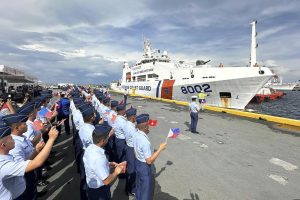A Vietnamese coast guard ship arrived in the Philippines yesterday for a four-day visit that will involve joint exercises on the fringes of the contested South China Sea. As the Associated Press reported, Vietnam Coast Guard (VCG) personnel “waved Philippine and Vietnamese flags and a brass band played under the morning sun at Manila’s harbor,” as CSB 8002, their 90-meter, 2,400-ton vessel, docked.
During the vessel’s stay in Manila, the countries’ two coast guard forces are expected to hold talks. The CSB 8002 will also join the Philippine Coast Guard (PCG)’s 83-metre offshore patrol vessel, BRP Gabriela Silang in carrying out search and rescue drills along with fire and explosion contingency drills in Manila Bay.
Col. Hoang Quoc Dat, who headed the VCG delegation, said in a speech that the Manila port call was a way to strengthen the two countries’ “cooperative relationship for mutual benefit” and would “promote and enhance the efficiency of information sharing and the coordination in maritime law enforcement, in accordance with international law.”
The trip comes at a time of heightened tension in the South China Sea, where the China Coast Guard (CCG) has become more muscular in its attempt to defend Beijing’s maximalist “nine-dash line” claim, which includes large swatches of ocean claimed by Vietnam, the Philippines, Malaysia, Brunei, and Indonesia.
A particular Chinese focus has been Second Thomas Shoal, where the CCG has sought to prevent the PCG and Philippine Navy from resupplying the small garrison aboard the BRP Sierra Madre, which Manila beached on the shoal in 1999. The loose Chinese blockade reached a crescendo on June 17, when personnel from the two coast guards came to direct blows, injuring a number of Filipino sailors, one seriously.
While the two nations have since reached a “provisional” arrangement allowing the peaceful resupply of the Sierra Madre, the underlying dispute remains unresolved.
The VCG’s goodwill visit is a welcome sign of cooperation between the Southeast Asian nations with claims in the South China Sea. This cooperation has been relatively lacking, in large part because these nations themselves have unresolved overlapping claims in resource-rich areas, which are charged with varying degrees of nationalistic investment. This has prevented these nations from forming a common stance regarding China’s overweening claims, which affect all of them.
Recent years have seen growing cooperation among and between the Southeast Asian claimants. During a state visit to Vietnam in January, Philippine President Ferdinand Marcos Jr. and his Vietnamese counterparts signed two agreements to boost cooperation between their coast guards and “incident prevention” in the South China Sea. During the trip, Marcos described Vietnam as “the sole strategic partner of the Philippines” in Southeast Asia and that “maritime cooperation is the foundation” of the strategic partnership established by Hanoi and Manila in 2015.
In June of this year, Vietnam said that it was ready to hold talks with the Philippines to settle their overlapping claims to the undersea continental shelf in the South China Sea. This came shortly after Manila asked a United Nations body to formally recognize its right to the undersea continental seabed extending from its western coast outward into the South China Sea, which runs up against Vietnam’s competing claim.
Yesterday, officials from both sides hailed the Vietnamese goodwill visit as a sign that the two sides could put aside their disputes in the interests of mutually beneficial cooperation.
“In spite of the rivalry, (Philippines and Vietnam) are also claimants on the West Philippine Sea, it shows we can work together,” PCG spokesperson Armando Balilo told reporters yesterday, according to Reuters. “Hopefully this will start a template that can be used even with China to de-escalate the situation.”

































